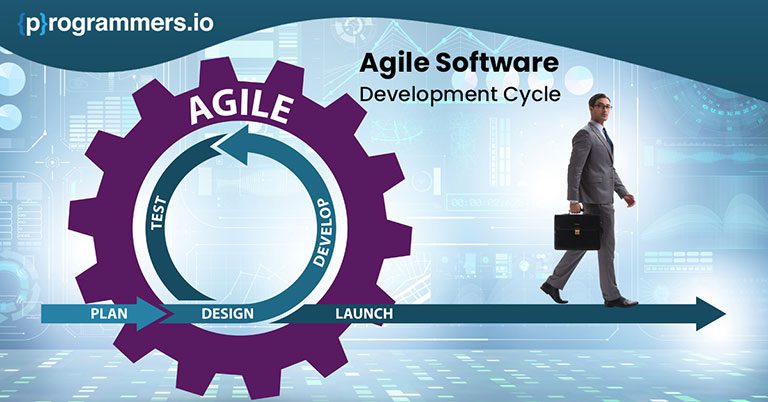The Agile Lifecycle for Software Development
The agile lifecycle for project management is distributed into multiple phases. Agile software development methodology is ideal for evolving and changing projects.
Adaptive planning involves breaking a project into small tasks or components. These components give you a better idea of your resources and the timeline they will follow. Adaptive planning may yield surprising outcomes; it challenges the uniformity of predictive planning to either give you surprisingly early finish times or extensive delays.
In short, the waterfall method is your ideal methodology for when objectives are known, and the agile method is perfect for evolving projects where you have to innovate
The software development life cycle is broken down into four unique phases; initiation, planning, execution and closure. These phases usually give you a path to follow from start to end. While some methodologies also include a fifth phase for controlling and monitoring, we believe that this phase can best be covered in the execution and closure phases.
In this article, we take a look at the different stages of the agile lifecycle and explain how they matter for software development. Stay with us for more.
Initiation
Every project is the end result of a brainchild, a session on brainstorming or the identification of a business or public need, opportunity or problem. During this first phase of the project life cycle, software developers and their teams figure out the reason behind their project. They also determine the major deliverables for this project and whether the project is feasible for them to undertake.
The initiation stage also gives programmers and leaders an opportunity to have their voices heard early in the proceedings. It is best to cement your control over the process before the strategy and guidelines are set in stone.
Project Management Steps for the Initiation Phase
Project leaders and teams take the following steps during a typical project initiation phase:
- Undertaking a feasibility study: The feasibility study helps in identifying the primary problem behind the project and how the project will help in solving it.
- Identifying scope: This step is related to defining the breadth and depth of a typical project.
- Identifying deliverables: More often than not, corporate projects end with the release of a new deliverable in the form of a product or a service. This is discussed during the initial phase so that things are made clear for the time to come.
- Identify project stakeholders: The initiation phase is also a good way to identify possible project stakeholders and who the project affects.
- Developing a statement of work: The statement of work basically documents the project’s scope, deliverables, objectives and all that you have identified previously as part of the discussions.
- Develop a Business Case: The information from your feasibility report can be used to compare the potential benefits and costs of a project. This helps determine whether you move forward with your project or not.
Planning
Once the project has the approval to move forward, based on the statement of work and project initiation, it moves into the planning phase. It is during the planning phase of the project management life cycle that teams break down the project into smaller, more manageable parts. This is also where a schedule of completion is prepared to prioritize all steps in the right manner. Consider these steps to be micro-objectives set along the course of the project. Small goals increase the potential of success.
Project Management Steps for the Planning Phase
Steps taken during the planning process include:
- Creating a Project Plan: The project timeline and all phases are set, along with possible constraints.
- Estimating Budget: Cost estimates are used to set a budget and create a financial plan.
- Create workflow: Workflow is visualized using interactive diagrams for the process.
- Gathering Resources: All resources, including team and financial resources, are gathered.
- Anticipating Risks: This is where all anticipated risks and roadblocks within the project are underlined and anticipated. All issues that may cause the project to stall are discussed in a bid to find ways to remediate them. Read more – common software issues
- A project kick-off meeting: Finally, the project is in action and a kickoff meeting sets expectations in order.
Diagrams, flowcharts and maps are an integral part of this phase.
Execution
Execution is the third step in the project life cycle and deals with the implementation of plans made in the planning process. The execution process is your call to turn your plan into action. This is where pen meets paper and businesses work on achieving timelines, organizing resources and following the original plans.
The steps followed in a typical execution phase include the following:
- Creating and organizing effective workflows: Tasks are effectively assigned to team members and all resources are utilized here.
- Briefing team members: Tasks are explained to team members and they are told of the progress made in the project on a periodic basis.
- Communicating progress to stakeholders: All progress within the task is reported to project stakeholders and people directly related to the tasks.
- Monitoring Quality: Quality assurance is an important part of the implementation process.
- Meeting Budget: Budgets set during the planning process are managed and followed during the implementation phase.
Closure
Once a business nears completion on a project, they have reached the closure phase. This phase of the project deals with handling the final deliverables and releasing project resources. Software developers have to sit and compile work after the finite processes in the project are over. Work done at the time of closure includes:
- Analyzing project performance: Software developers determine whether goals are met and the problems that persisted at the start are solved.
- Analyzing team performance: The input from every team member is analyzed at the time of closure.
- Documenting closure: The closure of a project should be appropriately documented. No loose ends should remain.
Following these phases to the dot allows software developers to better handle projects from start to finish. The agile software develop methodology and lifecycle help manage software development in a more thorough manner.











